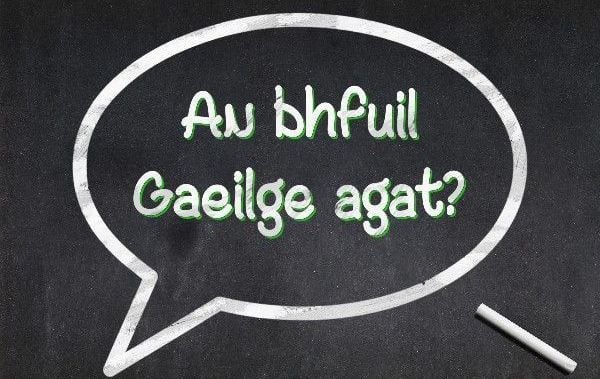Here's how you can learn the Irish language for free online no matter where in the world you are.
Learning Irish can be an expensive business if you’re located outside of Ireland. (And just to be clear for anybody that's unaware, we're talking about learning Irish Gaelic - a living language - here, not how to learn an Irish accent.)
We've put together a list of classes around the world here and you can find plenty more information on our Irish language section here.
However, thanks to developments in technology, geographical location is no longer a costly obstacle, and it's easy to find somewhere online offering ways to learn Irish Gaelic for beginners, with help on everything from Irish language pronunciation to Irish language phrases. While it's great to learn Irish dance or learn Irish fiddle, why not give how to learn Irish for beginners a go!
Here are some of the best ways to learn Irish for free and some of the measures you can use to integrate the language into your life.
Duolingo
Duolingo is the free language learning phone app and is the perfect way to learn Irish on the go and for free.
Even if you’ve only a few minutes to practice each day, this phone app allows you to spend them completing a lesson on the go before getting on with your busy schedule. In December 2020, it was reported that Irish is the fastest-growing language on the app, with more than one million people are actively learning Irish
The course is easily set out and accessible for complete beginners and for those just brushing up on their cúpla focail. It also offers a browser version where you can work on translating texts to practice further. Each question is linked to a discussion forum where learners can discuss wrong or right answers together and help each other learn.
Check out Duolingo's Irish offerings online here.
Clilstore
Clilstore is a collection of content and language-integrated learning (CLIL) teaching materials that link videos and their text with suitable online dictionaries.
CLIL is a teaching concept by which learners focus on a subject already familiar to them, such as a hobby, through the medium of the second language. They essentially acquire language skills while dealing with a topic they are comfortable with.
Clilstore currently offers 230 units in Irish over a range of abilities from teaching absolute beginners the words to the Irish national anthem to radio scripts for learners nearing fluency. Each unit contains a video where the pronunciation can be heard, a copy of the audio’s text and the ability to click on a word within this text to search among the compiled online dictionaries. Learners have easy access to a means of using their reading and listening skills and a well-developed dictionary tool in the absence of a teacher.
More information can be found at multidict.net/clilstore and search for 'Gaeilge' (meaning: Irish)
Social media
Many of us spend too much time on social media, so why not make good use of it and practice as much Irish as we can?
Both Facebook and Twitter currently allow you to switch to Gailege in your profile settings. While it may be difficult to grasp the new terminology to start off with, once you understand what a word means you are never going to forget it.
Apart from using the sites themselves in Irish, social media make it incredibly easy to connect with other Irish speakers, many of whom are willing to share their expertise and eager to use the language.
On Facebook, my recommendation would be the group “Gaeilge Amháin” (Irish Only). The group is strict on its Irish-language-only policy, but if you’re willing to make the effort, many of its over 11,000 members will be willing to answer your questions, guide you through your learning experience and act as a fantastic support group.
Over on Twitter, check out @IrishLanguage for resources and @TheIrishFor for Irish vocabulary.
Also, try to follow and engage with Irish speakers on Twitter. A full list of the language users was compiled by the American Irish-language tech whiz Kevin Scannell and can be found here, along with a list of some of the best Irish language blogs.
Some of my favorite Irish language speakers to follow are Maitiú Ó Coimín (@maitiuocoimin), Derek O'Brien (@DirkVanBryn), who provide witty, entertaining tweets and prove that Irish is a vibrant, creative language. Logainm.ie (@logainm_ie) also provides great insight into Irish place names.
Irish language media
Even for the advanced learner, the main Irish language media outlets Raidió na Gaeltachta and TG4 can be challenging (although subtitles on TG4 help).
If you’re a fan of pop music why not try Raidió Rí Rá – which mixes chart music with small easily understandable bits of entertainment news?
Raidió na Life is also more accessible for the Irish language learner as many of its volunteers are learners themselves. It also plays the most diverse music selection in Dublin with its highly contrasting shows and is well worth a listen for this alone.
TG4 creates some fantastically entertaining TV that will introduce you to Ireland, not just Irish. Top of my list is the channel’s soap opera Ros na Rún – it’s the only soap I will admit to watching.
Irish language news website Tuairisc.ie also offers reading comprehensions, crosswords, and video tasks and is a fantastic reading resource for advanced learners.
Read more
Use the Irish language option on your smartphone
As with Facebook, this, too, is a difficult one, to begin with. There have been many times I’ve been forced to change my phone back to English for a while to carry out what should have been a simple task.
My advice would be to go through the steps it takes to change the language on your phone, and keep a note of it before you change the language to Irish. This way, you will never get lost if you need to change back to English to discover what “Inrochtaineacht” means. (Accessibility!)
Complete immersion in a language is the best way to learn, which can be incredibly difficult when you’re expected to live your life through English. By making small changes such as this, you can ensure that at least a certain percentage of your day will always utilize your Irish skills.
Read more
Make use of other online resources
One of the best things about Irish is the incredibly talented and future-thinking group of speakers it breeds.
Far from being a dead language as others would have you believe, the Irish language can be learned through online resources from teenage app developers like Tearma.ie, to the Irish language version of Microsoft Office.
A good list of the resources and software available can be viewed at http://nascanna.com/.
Keep in contact with other learners and attend as many events as possible
This may seem like an obvious suggestion, but it can’t be overstated. Using Irish is the only foolproof way to learn.
When I first moved to New York, I was concerned about how my level of Irish would suffer after coming from an environment where it was my majority day-to-day language. Within weeks, I found a vibrant Gaeltacht community within the city and many new friends happy to discuss terminology and grammar points with me. All it took was a bit of bravery on my part in attending events I heard about online.
Attend Irish-language events if possible – it would be incredibly rare for anybody with an interest in learning Irish not to be welcomed with open arms.
If you know somebody who also has an interest, make a pact that you will spend at least an hour a week speaking Irish with them (if not more).
Make sure to get an email address or other contact information from any other speakers you meet with and keep as many email penpals as possible. This is vital if you don’t have easy access to events and will at least remind you that you’re not alone when the Tuiseal Ginideach gets too much.
The most important thing to remember is that practice makes perfect. You may listen for hours and still barely understand anything, but by adding an hour or two of radio or TV listening to your week, in combination with a more practical learning device such as Duolingo, you should begin to see improvements and nothing is better for your pronunciation.
* Originally published in 2015. Updated in March 2023.




Comments